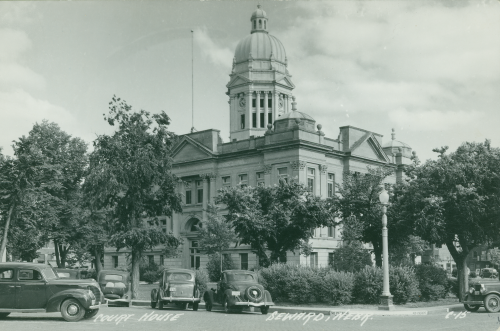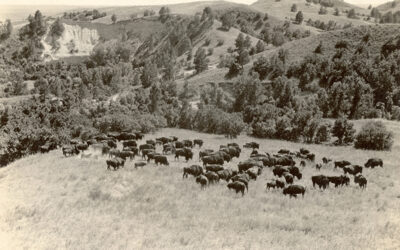Curious as to how various events influenced marital status, Concordia University history professor Jerrald K. Pfabe studied divorce rates in Seward County.
By Breanna Fanta, Editorial Assistant
Curious as to how various events influenced marital status, Concordia University history professor Jerrald K. Pfabe studied divorce rates in Seward County. In an article published in the Winter 2021 issue of the Nebraska History Magazine, he compares statistics from two historical periods against national trends, while sharing anecdotes of interesting cases.
Focusing on 1869-1906 and 1919-1948, Pfabe researched how events, such as the establishment of Seward County’s court (1869) and both world wars, impacted divorce rates.

(“Before the present courthouse was built in 1904, Seward County used various buildings for a courthouse. At the time of this circa-1884 phot, the courthouse was the upper story of a downtown building.” Detail of RG2546-5-7)
There were only two major legislative changes within the two periods: the introduction of the term “absolute divorce” (permanently ending the marriage and joint possession of property), and a statute that finalized divorces six months after the decree. Women were the more frequent petitioners in both periods, and more divorces were petitioned in later years.
While the data served as a great source of comparison, the case stories provided greater social insight.
Before modern “no-fault divorce,” divorce was granted only in cases of wrongdoing. In many cases people filed for divorce under multiple citations, such as Adultery, Physical Incompetence, Imprisonment, Desertion, Habitual Drunkenness, Extreme Cruelty, and Neglect (husband provides insufficient support or there is a lack of resources). The two most common citations during both periods were Extreme Cruelty and Neglect.
Extreme cruelty often entailed physical and psychological abuse. In a few cases, women complained about overly controlling husbands who restricted them from attending social events.
In most cases, the abuse came from the husband, but not always. In 1922 Charles Smith filed for divorce from his Bessie, alleging that she was violent and negligent. He also said that Bessie was not a good housekeeper, didn’t take care of their child, and would flirt with other men. He said she was constantly unhappy at home and eventually deserted him.
Bessie responded saying that Seward County had no jurisdiction because she previously filed for divorce elsewhere. According to her, she left Smith after enduring abuse over the span of two years. During that time she filed for divorce but dismissed that case after Smith apologized.
In April 1923, Bessie was granted absolute divorce and received custody of the child.

(“The Seward County Courthouse circa 1938-39.” RG2536-5-16)
Since divorces could not be finalized until six months after the decree, some couples apparently resolved their conflicts and dismissed their case prior to the deadline. This was not the case for Albert Zimmerman, who remarried before the deadline and in turn was imprisoned for bigamy. His bride promptly divorced him.
In both periods, most people were married for about eight or nine years before getting divorced. In cases involving shorter marriages, women commonly restored their maiden name. Helen Navratil was an exception, as she restored her maiden name after divorcing her husband of more than 16 years.
Childless women frequently restored their name. When children were involved, courts were more interested in handling custody matters—a decision left to the court’s discretion.
Many of Seward County’s divorce cases involved children, and the courts seemed to favor maternal custody. When husbands questioned custody rulings, they rarely requested custody themselves and instead suggested close relatives as caretaker. Visitation was also rarely granted in early cases.
Fern and Clifford Koerting heavily disputed their custody and visitation agreement. When they were divorced, Fern’s parents were granted custody of their child. Clifford argued eight years later that the child was not appropriately disciplined and claimed that the parents were violating the agreement by granting Fern extended visitation. Clifford requested that either he receive or his brother in New York should be granted custody. Fern, who remarried and had another child, was deemed the better fit and was granted custody. Clifford later denied paternity after accusing Fern of cheating while he was in the military.
War commonly strained marriages and created tensions in young relationships. Of the eight divorces in Seward County linked to World War II, a majority were couples who married quickly before their spouse entered the service. War conditions tested relationships, and newlyweds who had had little time to establish a marital relationship were particularly vulnerable.
The marriage of Lee and Maxine P. (surname omitted out of consideration for the family) fell victim to wartime stresses. They married in February 1942 before Lee’s military induction. While he was away, Maxine wrote to him about joining the Women’s Army Auxiliary Corps (WAAC). He urged her not to join, fearing that it would jeopardize their young marriage. She joined anyway and grew fond of the work.
After being discharged in late September, Lee wired her to ask if they could meet. She did not respond. He continuously attempted to contact her, and after arranging a meeting in an Omaha hotel lobby, she refused a private meeting. Despite his persistence, she continued to decline. When he called her on New Year’s Day 1946, she asked for a divorce.
Through exploring Seward County’s divorce cases, we get a closer look at national trends through a more local scope. While the couples described in the article probably expected long, happy marriages, their stories provide a view into the history of divorce.
The entire article can be found in the Winter 2021 edition of the Nebraska History Magazine. Members receive four issues per year.



